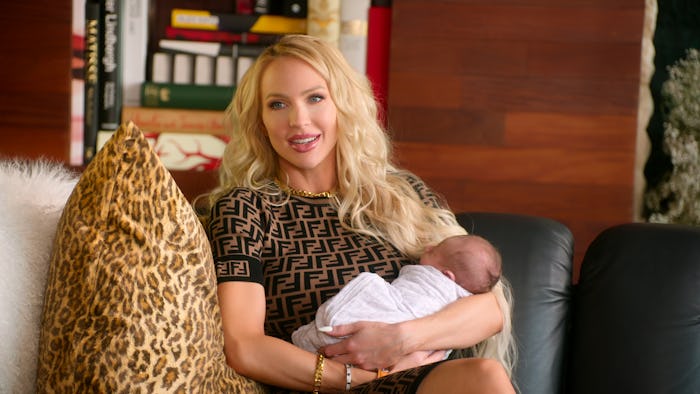Entertainment

We Need To Talk About Christine's Absurd Recovery From Childbirth On Selling Sunset
The portrayal of Christine Quinn’s pregnancy and recovery from a traumatic birth in Season 4 is straight-up irresponsible.
There’s a scene on this season’s Netflix show Selling Sunset where Christine Quinn — real estate agent and pitch-perfect reality show villain, the Cruella de Vil of the Sunset Strip — comes downstairs in her palatial Los Angeles home to introduce her newborn baby to two of her co-workers, wearing a form-fitting Fendi dress and heels. Her makeup is flawless; her butt-length platinum blonde hair cascades down her back in waves — a process that she has said takes two and a half to three hours. Her co-workers say, approvingly, that she looks “tiny” and “great”; we are led to understand, via a confessional that is intercut with the scene, that Christine is a mere few days out from giving birth. “I’m surprisingly doing good,” she says. In the confessional, she is wearing a sparkly silver dress with a matching choker, and her hair is styled in a sleek high ponytail. “The baby’s doing amazing. He’s a perfect little angel and I couldn’t be happier.”
But we soon learn that her son’s birth was anything but amazing. According to Christine, she was 9 centimeters dilated when she got to the hospital, her son’s umbilical cord was wrapped around him, and he was also on his side. An emergency cesarean section was the only option, but, she says, her heart rate was going down, the baby’s heart rate was going down, and she heard a nurse tell her husband that he needed to “make a priority right now. You need to choose one.” She continues, “It was literally a nightmare.”
Over four seasons, Selling Sunset has become a semi-absurd show about the very thin, mostly blonde employees of a real estate brokerage in Los Angeles, who seem tangentially concerned with selling real estate and mostly concerned with which “girls” are friends with each other at any given moment, the television equivalent of the Marie Antoinette cotton candy dessert at Barton G’s — fascinating, over-the-top, and ultimately kind of gross to actually eat. (Their boss is a man who has dated at least one of them and is currently dating another, lending the proceedings an occasionally uncomfortable kind of pimp/harem vibe.) In this context, then, Christine’s confession is especially jarring, a dose of actual reality in the surrounding melodrama.
As someone who had an unplanned (but not emergency) C-section after 40 hours of an attempted induction, I felt I could relate, in part, to her traumatic birth story. And yet, the aftermath of her son’s birth felt anything but relatable. “A few days” after I gave birth to my son, I had just gotten home from the hospital. I was wearing an abdominal binder, but had to be careful to position it above my C-section scar, which still had stitches in it. Getting out of bed was still painful — I never realized how much I relied on my abs to, you know, do most things. My breasts were engorged and painful, and when I wasn’t attempting to nurse (which, thanks to my flat nipples, hurt like hell even with nipple shields), I was attempting to pump. I don’t think I got out of my pajamas for at least a week.
It’s hard to believe that Christine would be clomping around a listing appointment in a crop top and mini skirt and what appears to be a new spray tan less than three weeks after this incredibly traumatic, “nightmare” emergency C-section. But Christine seems determined to make this traumatic birth story and seemingly instant recovery part of her narrative of being a “boss b*tch,” as she wrote on Instagram when her son was 2 months old. (Coincidentally, she’s publishing a memoir in May called How to Be a Boss B*tch.)
Still, I wasn’t even cleared for driving until two weeks had gone by, and I wasn’t allowed to exercise for six weeks — and even then, I was advised to take it very, very slow. Indeed, for most women, Christine’s recovery is impossible and, in fact, unwise. And perhaps you’re thinking, but she’s a reality star — why should we expect her recovery to look anything like a regular person’s? In fact, her recovery seemed so suspiciously fast that some people on social media argued that she had faked her pregnancy, which she has categorically denied.
I’m not going to litigate whether or not Christine faked her pregnancy — all I have to go on is what she put on social media, what she’s said in the press, and what has been portrayed on the show. But, I would argue, the portrayal of Christine’s pregnancy and recovery is irresponsible. In the pursuit of a melodramatic plotline, the editing feels like it exploited an actually traumatizing situation, simply to play into this narrative of the post-birth “snapback” and make all the other cast members jealous.
It also implies that — traumatic birth notwithstanding — pregnancy is, ultimately, no big deal. Look hot in your pregnancy photo shoot and if you almost flatline giving birth, don’t worry, you can wear a crop top two weeks later! This matters in a world in which a Supreme Court Justice says that adoption can “take care of that problem,” because — as the writer and podcaster Josie Duffy Rice put it on Twitter — “giving birth is major surgery and the six of these justices are pretending the severity of pregnancy is equivalent to getting a haircut.” Perhaps the next time someone on this show gives birth, we’ll get to see some real postpartum struggles — even if they are still in hair and makeup.
Doree Shafrir is the author of the memoir Thanks For Waiting: The Joy & Weirdness of Being a Late Bloomer, and the novel Startup. She is also the co-host of the podcasts Forever35 and Matt & Doree's Eggcellent Adventure.